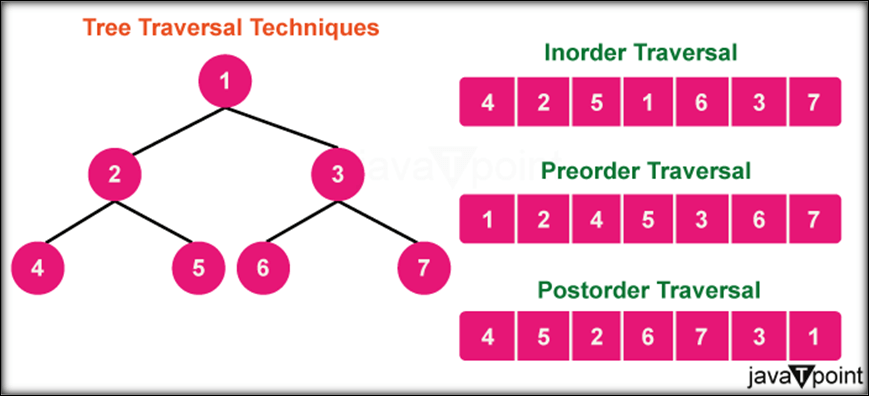If you are given two traversal sequences, can you construct the binary tree?Binary trees are fundamental data structures used to organize data hierarchically. They have many applications in computer science, from storing sorted data in binary search trees to representing expression parse trees. A key aspect of binary trees is how to traverse them - visiting each node systematically to process or print the data it contains. The three most common traversal methods are inorder, preorder, and postorder, each producing a different node visiting order. Given the node values in a binary tree, we can traverse it using these techniques and obtain the sequence of visited nodes. An interesting question is, if we are only given the traversal sequences, can we reconstruct the original binary tree uniquely? 
This article explores algorithms to reconstruct binary trees from their inorder and preorder (or postorder) traversal sequences. We discuss how the different traversal sequences encode information about the tree structure and node relationships. An efficient O(n^2) algorithm is presented that recursively divides the traversals to build the left and right subtrees and, hence, the original tree. Being able to reconstruct binary trees from traversals has usefulness in several contexts. It helps recover tree structures from traversal data. It also provides insights into the properties of different traversal techniques. This algorithmic problem demonstrates how complex tree structures can be systematically processed and analyzed. Inorder Traversal:The inorder traversal involves traversing the left subtree first, visiting the root node, and then traversing the right subtree. For example, for the binary tree:
For example, for the binary tree: Inorder traversal prints: 4 2 5 1 3 In inorder, the root node is visited between the subtrees, so the traversal tends to produce sorted output. Uses: Produces sorted output, so it is helpful for binary search trees. Preorder Traversal:The preorder traversal visits the root node first, then traverses the left subtree, followed by the right subtree. For the example tree, the preorder order would be: A, B, D, E, C In preorder, the root node is visited first before its subtrees.
For the same example tree, preorder traversal prints: 1 2 4 5 3 Uses: Creates a copy of the tree, helps in constructing the tree from traversal order Postorder Traversal:The postorder traversal involves traversing the left subtree first, then the right subtree, and finally visiting the root node. For the same example tree, the postorder traversal order would be: D E B C A In postorder, the root node is visited last after the traversed subtrees.
For the example, postorder is: 4 5 2 3 1 Uses: Deletes tree nodes safely, computes expressions with parentheses Level Order Traversal:The level order traversal visits tree nodes level-by-level from left to right. For the example tree, the level order traversal would be A B C D E. The nodes are visited in increasing order of their depth or level in the tree. Level order traversal uses a queue to traverse the tree.
For the example, level order traversal prints: 1 2 3 4 5 Uses: Prints level-wise hierarchy, used in breadth-first search Algorithm to form a Binary TreesThe three standard traversal methods for a binary tree are inorder, preorder and postorder traversals. Inorder traversal visits the left subtree, the root node, and the right subtree. Preorder traversal visits the root node first, followed by the left and right subtree. Postorder traversal visits the left subtree, the right subtree, and the root node. Out of these three traversal sequences, any two can be used to uniquely construct the original binary tree. This is because inorder traversal gives the node values in sorted order, while preorder and postorder encode the position of the root node relative to its subtrees. The algorithm for reconstructing a binary tree given its inorder and preorder traversals is as follows:
For example, consider a binary tree with inorder traversal as DBEAFC and preorder as ABCDEF. The first element of preorder is A - this is the root node. In inorder, DBE belong to left subtree of A, and CEF belong to right subtree. We recursively construct the left subtree using subsequence DBE in inorder and ABC in preorder. This gives us the left subtree. The right subtree is made using EF in inorder and DEF in preorder. We get the original binary tree by attaching left and right subtrees to A. The time complexity of this algorithm is O(n^2) since finding the root node partition in inorder takes O(n) time and we repeat this for O(n) nodes. The space complexity is O(n) for the recursion stack. A similar reconstruction process applies to inorder and postorder sequences. Here are the steps to reconstruct a binary tree given its inorder and postorder traversal sequences:
The key differences between using inorder and preorder are:
For example, if the inorder sequence is DBEAFC and the postorder is DEBFCA, then:
This reconstructs the original binary tree from inorder and postorder traversals. The overall time and space complexity is the same as using inorder and preorder. In summary, given any two inorder, preorder and postorder traversals, we can uniquely reconstruct the original binary tree. The key lies in using one sequence (in order) to identify node relationships and the root node position from the other sequence to recursively build subtrees systematically. This demonstrates how different traversal methods encode complementary information about a binary tree structure. |
 For Videos Join Our Youtube Channel: Join Now
For Videos Join Our Youtube Channel: Join Now
Feedback
- Send your Feedback to [email protected]
Help Others, Please Share









